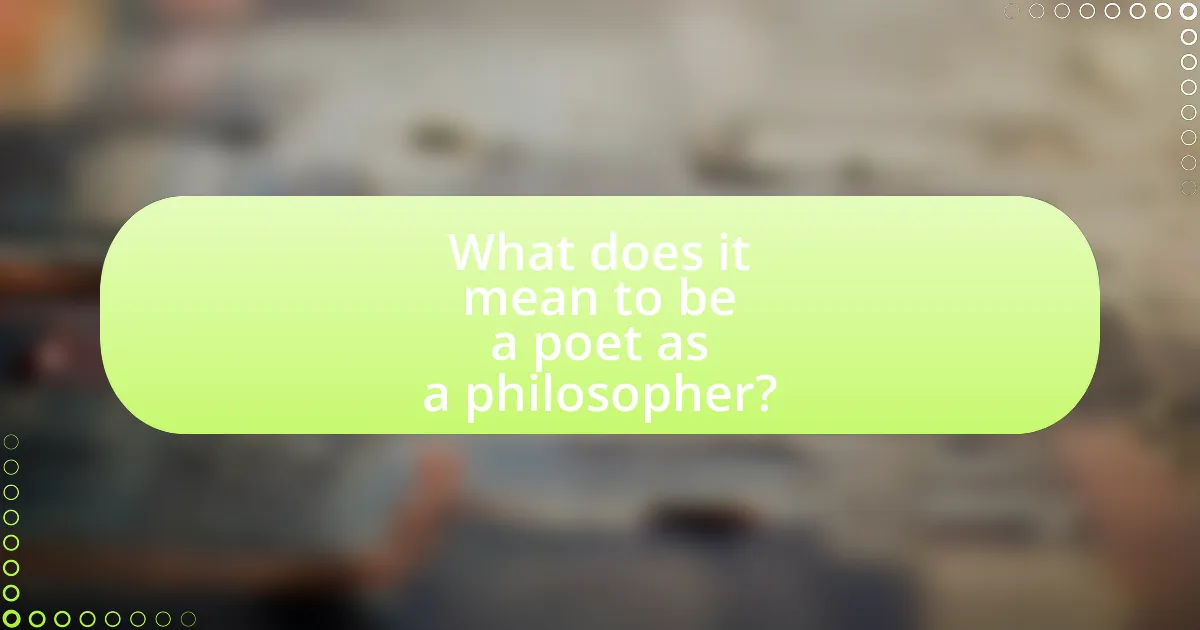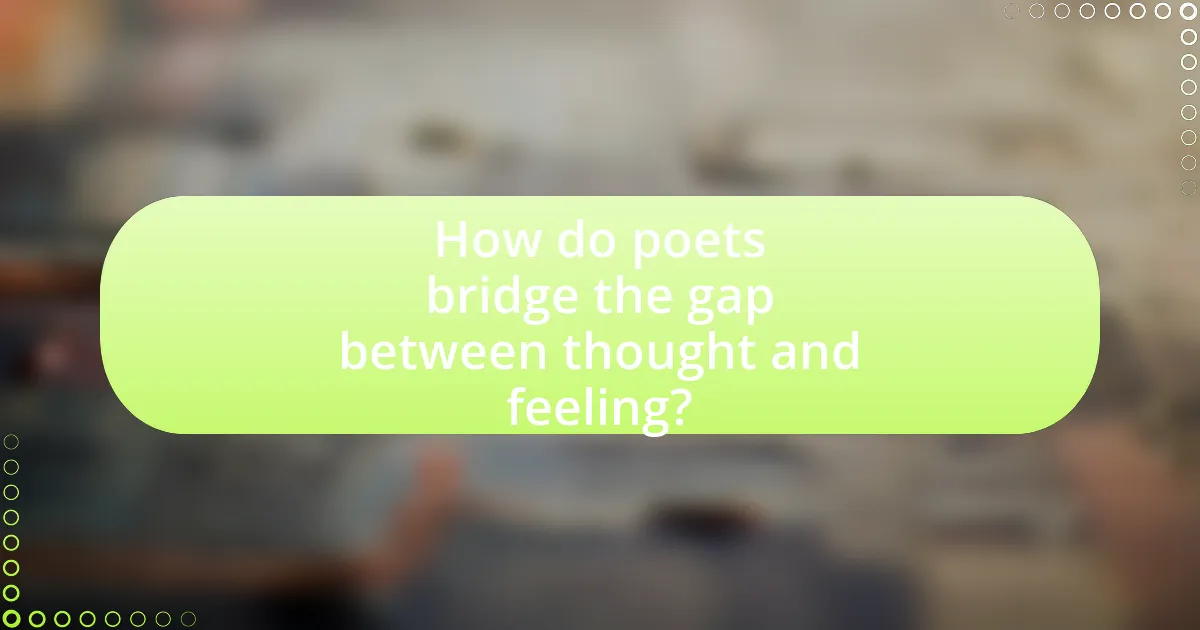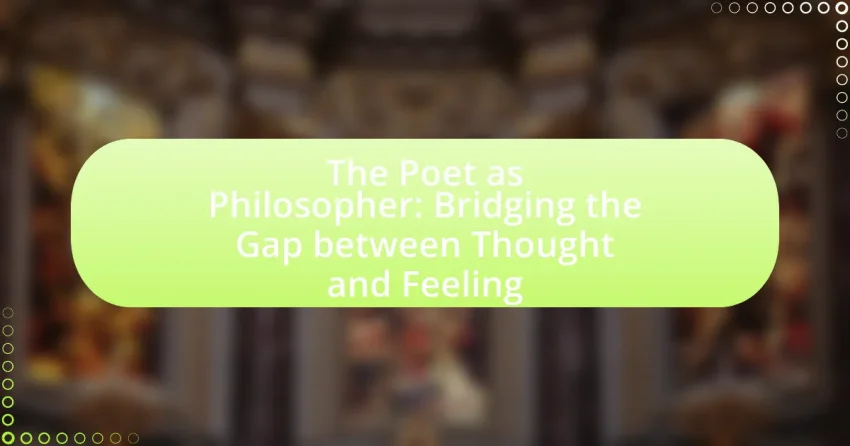The article explores the concept of the poet as a philosopher, emphasizing the integration of poetic expression with philosophical inquiry to articulate complex ideas and emotions. It examines how poets utilize techniques such as imagery, metaphor, and structure to convey philosophical themes related to existence, morality, and the human condition. The relationship between thought and feeling is highlighted as significant in enhancing emotional resonance and intellectual engagement, with examples from notable poets like Friedrich Nietzsche, John Keats, and Rainer Maria Rilke. Additionally, the article discusses practical approaches for analyzing poetry through a philosophical lens and offers exercises to inspire creative expression that reflects philosophical inquiry.

What does it mean to be a poet as a philosopher?
Being a poet as a philosopher means engaging in the exploration of profound truths and human experiences through the lens of poetic expression. This dual role allows the individual to articulate complex ideas and emotions in a way that transcends conventional reasoning, often revealing insights about existence, morality, and the human condition. Historical figures like Friedrich Nietzsche and Rainer Maria Rilke exemplify this integration, as they combined philosophical inquiry with poetic language to deepen understanding of life’s intricacies. Their works demonstrate how poetry can serve as a vehicle for philosophical thought, making abstract concepts more accessible and emotionally resonant.
How do poets express philosophical ideas through their work?
Poets express philosophical ideas through their work by employing imagery, metaphor, and structure to explore complex concepts such as existence, morality, and the human condition. For instance, the use of metaphor allows poets to convey abstract philosophical notions in relatable terms, as seen in John Keats’ “Ode to a Nightingale,” where the nightingale symbolizes transcendent beauty and the fleeting nature of life. Additionally, poets often utilize structured forms, such as sonnets or free verse, to create a rhythm that mirrors the philosophical themes they are addressing, enhancing the emotional impact of their ideas. This interplay between form and content enables poets to engage readers in deep reflection, prompting them to consider their own beliefs and experiences in relation to the philosophical questions posed in the poetry.
What techniques do poets use to convey complex thoughts and feelings?
Poets use various techniques such as imagery, metaphor, symbolism, and enjambment to convey complex thoughts and feelings. Imagery allows poets to create vivid mental pictures that evoke emotions, while metaphor provides deeper meanings by comparing disparate elements, enhancing the reader’s understanding of abstract concepts. Symbolism assigns specific meanings to objects or actions, allowing for layered interpretations of feelings and ideas. Enjambment, the continuation of a sentence without a pause beyond the end of a line, creates a sense of urgency and fluidity, reflecting the complexity of human emotions. These techniques enable poets to articulate intricate emotional landscapes and philosophical inquiries, making their work resonate on multiple levels.
How does the language of poetry differ from philosophical discourse?
The language of poetry differs from philosophical discourse primarily in its use of emotional resonance and aesthetic form. Poetry employs figurative language, rhythm, and imagery to evoke feelings and create sensory experiences, while philosophical discourse prioritizes logical reasoning, clarity, and argumentative structure to explore abstract concepts. For instance, poets like John Keats utilize vivid imagery and metaphor to convey complex emotions, whereas philosophers like Immanuel Kant focus on systematic argumentation to address metaphysical questions. This distinction highlights how poetry seeks to connect with the reader’s emotions, while philosophy aims to engage the intellect through rational analysis.
Why is the relationship between thought and feeling significant in poetry?
The relationship between thought and feeling is significant in poetry because it creates a deeper emotional resonance and intellectual engagement for the reader. Poetry often serves as a medium through which complex emotions are articulated, allowing thoughts to be expressed in a way that evokes feelings. For instance, the works of poets like John Keats and Emily Dickinson illustrate how the interplay of cognitive reflection and emotional depth can lead to profound insights about the human experience. This connection enhances the reader’s understanding and appreciation of the poem, as it invites them to explore both the intellectual and emotional dimensions of the text.
How do emotions enhance philosophical arguments in poetry?
Emotions enhance philosophical arguments in poetry by providing depth and relatability to abstract concepts. When poets express emotions, they create a visceral connection that allows readers to engage with philosophical ideas on a personal level. For instance, the use of imagery and emotional language can illustrate complex themes such as existence, morality, and identity, making them more accessible. This connection is evident in works like John Keats’ “Ode to a Nightingale,” where the interplay of beauty and mortality evokes profound reflections on life and death. Such emotional resonance not only enriches the philosophical discourse but also invites readers to reflect on their own experiences, thereby deepening their understanding of the philosophical arguments presented.
What role does personal experience play in a poet’s philosophical perspective?
Personal experience significantly shapes a poet’s philosophical perspective by providing the emotional and contextual foundation for their reflections on existence. This connection allows poets to translate their lived experiences into universal themes, enabling readers to engage with complex ideas through relatable narratives. For instance, poets like William Wordsworth and Sylvia Plath drew heavily from their personal struggles and joys, which informed their views on nature, identity, and mental health. Their works illustrate how individual experiences can lead to broader philosophical inquiries, demonstrating that personal narratives are essential in crafting a poet’s unique worldview.

How do poets bridge the gap between thought and feeling?
Poets bridge the gap between thought and feeling by using language that evokes emotional responses while articulating complex ideas. Through techniques such as imagery, metaphor, and rhythm, poets create a sensory experience that resonates with readers on an emotional level. For instance, the use of vivid imagery allows readers to visualize and feel the emotions being expressed, while metaphors can encapsulate abstract thoughts in relatable terms. This interplay between emotional resonance and intellectual engagement enables poets to convey profound insights about the human experience, effectively merging cognitive understanding with emotional depth.
What are the key elements that facilitate this bridging?
The key elements that facilitate the bridging between thought and feeling in the context of poetry include language, imagery, and emotional resonance. Language serves as the primary medium through which poets articulate complex ideas and emotions, allowing for nuanced expression. Imagery enhances this connection by creating vivid mental pictures that evoke feelings and stimulate the imagination, making abstract concepts more tangible. Emotional resonance is crucial as it enables readers to connect personally with the poem, fostering empathy and understanding. These elements work together to create a cohesive experience that merges intellectual insight with emotional depth, exemplified in works by poets like Rainer Maria Rilke and John Keats, who effectively blend philosophical inquiry with emotional exploration.
How does imagery contribute to the connection between thought and feeling?
Imagery enhances the connection between thought and feeling by creating vivid mental representations that evoke emotional responses. When individuals engage with imagery, it stimulates the brain’s emotional centers, allowing abstract thoughts to be translated into tangible feelings. Research indicates that imagery activates the same neural pathways involved in actual experiences, reinforcing the emotional weight of thoughts. For example, studies in cognitive psychology show that visual imagery can elicit strong emotional reactions, as seen in the work of Kosslyn et al. (2001), which demonstrates how mental images can trigger feelings similar to those experienced during real-life events. This interplay between imagery, thought, and emotion underscores the role of imagery in bridging cognitive and affective domains.
What is the impact of rhythm and sound on the emotional experience of poetry?
Rhythm and sound significantly enhance the emotional experience of poetry by creating a musical quality that resonates with readers. The interplay of meter, rhyme, and sound devices like alliteration and assonance evokes specific feelings and moods, influencing how the content is perceived. For instance, a steady rhythm can instill a sense of calm, while abrupt changes in sound can create tension or urgency. Research by Patricia Kain in “The Role of Sound in Poetry” highlights that auditory elements can trigger emotional responses, as they engage the brain’s emotional centers more effectively than text alone. This demonstrates that rhythm and sound are not merely decorative but integral to the emotional depth and impact of poetic works.
In what ways do poets challenge traditional philosophical boundaries?
Poets challenge traditional philosophical boundaries by employing language that transcends logical reasoning, allowing for emotional and subjective experiences to inform understanding. This approach contrasts with conventional philosophy, which often prioritizes rationality and objective analysis. For instance, poets like Rainer Maria Rilke and John Keats utilize imagery and metaphor to explore existential themes, thereby inviting readers to engage with complex ideas through personal interpretation rather than strict logical frameworks. This blending of emotion and intellect enables a more holistic exploration of human experience, demonstrating that philosophical inquiry can be enriched by the insights offered through poetic expression.
How do poets reinterpret philosophical concepts through their work?
Poets reinterpret philosophical concepts through their work by embedding complex ideas into emotional and sensory language, making abstract thoughts accessible and relatable. For instance, Rainer Maria Rilke’s poetry often explores existential themes, such as the nature of being and the search for meaning, using vivid imagery and personal reflection to convey philosophical inquiries. This approach allows readers to engage with philosophical concepts on an emotional level, facilitating a deeper understanding of ideas like existence and identity. Additionally, poets like John Keats have employed the concept of “negative capability,” which emphasizes the importance of embracing uncertainty and ambiguity, thus inviting readers to reflect on the philosophical implications of knowledge and perception. Through these methods, poets effectively bridge the gap between intellectual thought and emotional experience, demonstrating the interplay between philosophy and art.
What examples illustrate the fusion of poetry and philosophy in literature?
Examples that illustrate the fusion of poetry and philosophy in literature include the works of Friedrich Nietzsche, particularly “Thus Spoke Zarathustra,” which combines poetic language with philosophical ideas about morality and existence. Another example is the poetry of John Keats, whose odes often explore philosophical themes such as beauty and transience, reflecting on the nature of human experience. Additionally, T.S. Eliot’s “The Waste Land” merges poetic form with philosophical inquiry into modernity and despair, showcasing how poetry can convey complex philosophical concepts. These examples demonstrate how literary figures have effectively blended poetic expression with philosophical thought, enriching both disciplines.

What insights can we gain from the poet-philosopher relationship?
The poet-philosopher relationship reveals the interconnectedness of emotional depth and intellectual rigor. This relationship illustrates how poetry can encapsulate complex philosophical ideas in a manner that resonates emotionally, making abstract concepts more accessible. For instance, Friedrich Nietzsche, who was both a philosopher and a poet, used poetic language to express profound existential themes, demonstrating that the fusion of these disciplines can lead to a richer understanding of human experience. Additionally, the works of Rainer Maria Rilke, who blended poetic imagery with philosophical inquiry, show how this relationship can foster a deeper exploration of identity and existence. Thus, the insights gained from this relationship highlight the importance of integrating emotional and intellectual perspectives to enhance our comprehension of life’s complexities.
How can understanding this relationship enhance our appreciation of poetry?
Understanding the relationship between philosophical thought and poetic expression enhances our appreciation of poetry by revealing the depth of meaning and emotional resonance within the text. This connection allows readers to recognize how poets articulate complex ideas and feelings, often reflecting profound truths about the human experience. For instance, the works of poets like John Keats and Rainer Maria Rilke demonstrate how philosophical inquiries into existence and beauty can be woven into lyrical language, enriching the reader’s engagement with the poem. By exploring these intersections, readers gain insight into the intentionality behind word choices and imagery, fostering a deeper emotional and intellectual connection to the poetry.
What are the benefits of reading poetry with a philosophical lens?
Reading poetry with a philosophical lens enhances critical thinking and emotional depth. This approach allows readers to explore complex themes such as existence, morality, and human experience, fostering a deeper understanding of both the text and their own beliefs. For instance, philosophers like Friedrich Nietzsche and Rainer Maria Rilke have used poetry to articulate profound existential questions, demonstrating how poetic language can encapsulate intricate philosophical ideas. Engaging with poetry in this way encourages reflection and dialogue, ultimately enriching the reader’s intellectual and emotional landscape.
How can this understanding influence our own creative expression?
Understanding the relationship between thought and feeling can significantly enhance our creative expression by allowing us to integrate deeper emotional insights into our work. This integration fosters authenticity, as artists who grasp this connection can convey complex emotions and ideas more effectively, resonating with their audience on multiple levels. Research indicates that emotional intelligence, which encompasses the ability to understand and manage emotions, is linked to creativity; individuals with higher emotional intelligence often produce more innovative and impactful artistic works. Thus, by embracing this understanding, creators can enrich their artistic output, making it more relatable and profound.
What practical approaches can we take to explore poetry as philosophy?
To explore poetry as philosophy, one practical approach is to analyze poetic texts through philosophical frameworks, such as existentialism or ethics. This method allows readers to uncover deeper meanings and philosophical questions embedded within the poems. For instance, examining Rainer Maria Rilke’s “Letters to a Young Poet” reveals existential themes about the nature of existence and the self, demonstrating how poetry can articulate complex philosophical ideas. Engaging in discussions or writing reflective essays on these themes further solidifies the connection between poetry and philosophical inquiry.
How can we analyze poems to uncover their philosophical dimensions?
To analyze poems and uncover their philosophical dimensions, one must examine the themes, imagery, and language used by the poet. This involves identifying the central ideas presented in the poem, such as existence, morality, and the nature of reality, which often reflect philosophical inquiries. For instance, the use of metaphors can reveal deeper meanings and invite readers to contemplate complex concepts, as seen in the works of poets like John Keats and T.S. Eliot, who explore existential themes through rich imagery and symbolism. Additionally, analyzing the structure and form of the poem can provide insights into the poet’s philosophical stance, as the arrangement of lines and stanzas may mirror the progression of thought or argument. By engaging with the text critically and considering historical and cultural contexts, readers can better understand how the poem articulates philosophical ideas, thus bridging the gap between thought and feeling.
What exercises can help us write poetry that reflects philosophical inquiry?
Engaging in reflective writing exercises can help create poetry that reflects philosophical inquiry. One effective exercise is to select a philosophical question, such as “What is the nature of reality?” and write a series of free verse poems exploring different perspectives on that question. This method encourages deep thinking and personal interpretation, allowing the poet to connect abstract concepts with emotional experiences.
Another exercise involves reading philosophical texts and distilling key ideas into poetic forms, such as haikus or sonnets. This practice not only enhances understanding of philosophical themes but also fosters creativity in expressing complex thoughts succinctly.
Additionally, participating in group discussions about philosophical topics and then writing poems based on those conversations can provide diverse viewpoints and inspire new poetic expressions. This collaborative approach enriches the writing process and deepens the exploration of philosophical ideas through poetry.
